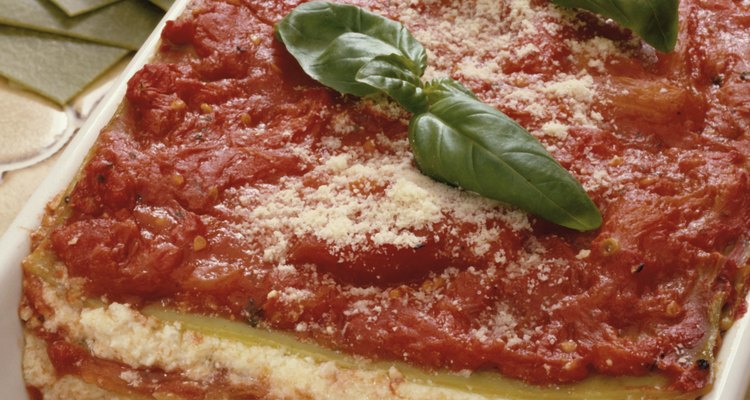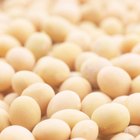
Non-boiled lasagna noodles cut the prep time for homemade lasagna by at least 15 to 20 minutes, but if you don't have any of the no-boil style on hand, you can use regular boiled lasagna noodles. Altering the recipe slightly accommodates the differences between the noodles, but you can use the same quantity.
Characteristics
An understanding of the differences between regular boiled lasagna noodles and no-boil or oven-ready noodles is essential if you're going to substitute one for the other. Regular boiled noodles have been dried prior to packaging. They must be boiled until tender before assembling them in a lasagna. No-boil lasagna noodles often are thinner than regular lasagna noodles and were partially cooked in a water bath before they were dried and packaged. They don't require boiling, but they need additional liquid to reconstitute them during baking.
Ingredients
Because oven-ready noodles aren't boiled before they're assembled in a lasagna, they need larger amounts of sauce to become tender. The sauce also is typically thinner than the sauce used in a traditional lasagna. Some recipes even call for added water. When you substitute regular boiled lasagna noodles for no-boil lasagna noodles, reduce the amount of sauce. A thicker sauce is also more appropriate for the heartier noodles.
Preparation
No-boil lasagna noodles are a handy convenience item because they don't require the additional step of boiling. If you're substituting regular lasagna noodles, they must be boiled and drained first. Lasagnas that contain no-boil noodles should be kept tightly covered with a lid or foil during baking so the steam can help cook the noodles. If you've already cooked the lasagna noodles, tent the foil loosely over the lasagna instead and remove it during the last five minutes of cooking to brown the top.
Differences
If you adjust the amount of sauce, as well as the cooking method, you'll likely be satisfied with substituting boiled lasagna noodles for no-boil noodles. Even with these adjustments, though, there is a difference in texture and taste between the two types of noodles. No-boil noodles are thinner and more delicate, while boiled noodles are thicker and seem to have more starch. In a pinch, the two are interchangeable, but you might find you prefer one over the other.
Related Articles

The Difference Between No-Boil & ...

Can I Pour Hot Water in a Baking Dish ...

How to Cook Luglug Cornstarch Noodles

Directions on How to Cook Soba Noodles

How to Cook Raw Chickpeas or Garbanzo ...

Do You Need to Cook Fresh Made Lasagna ...

How to Keep Meatballs Moist While ...

Difference Between Cellophane Noodles & ...

What Are Chicken Granules?

How to Make Homemade Boiled Starch

How to Cook Beans

How to Freeze Lentils

Cooking Frozen Potato Gnocchi in Butter

How to Rehydrate Chickpeas

How to Soak Adzuki Beans

Can You Use Starch on Linen Pants?

How to Steam Cook Bratwurst

Can You Use Milk Instead of Cream for ...

How to Reheat Leftover Pork Chops ...

Cooking Dried Banh Pho Noodles
References
Writer Bio
Julie Christensen is a food writer, caterer, and mom-chef. She's the creator of MarmaladeMom.org, dedicated to family fun and delicious food, and released a book titled "More Than Pot Roast: Fast, Fresh Slow Cooker Recipes."
Photo Credits
Ablestock.com/AbleStock.com/Getty Images